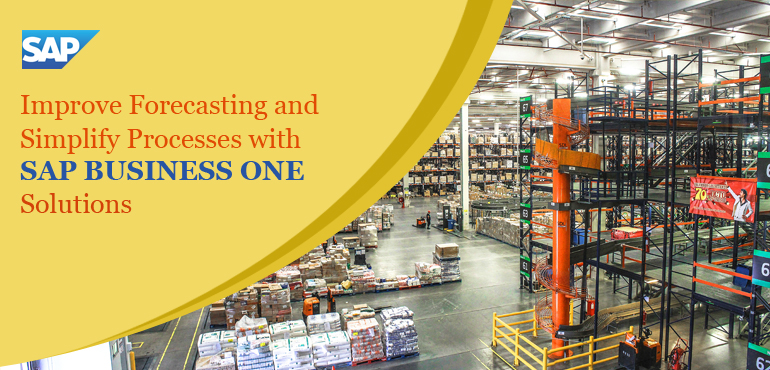Inventory happens to be one of the biggest cost overheads for both small & midsize businesses. For example, carrying too much of stock and getting tied up far too much with working capital and long stock cycles can be adverse to the cash flow. At the same time, if you are carrying fewer stocks this can affect your conversion rate, and profitability, as you will be unable to provide the products on time. Balancing accurate inventory management with cost-effective production is critical to businesses that aim to satisfy their customers with quality and timely delivery. The business’ overall profitability is dependent on various factors such as COGS, Cost of Raw Goods, and Overheads& Utilities. Inventory management is one of the best indicators of an organisation’s success.
Inventory management mainly depends on three things: people, processes, and technology.
Apart from having the right people, we will have a look on other two factors- Processes and technology.
Learn more about how processes affect inventory management.
Process – Cycle Counting
Beloware five advantages to staying on top of your inventory numbers through regular cycle counting:
- You won’t have to forfeit sales due to out-of-stock situations.
- You don’t waste money in overstocked inventory (i.e. yourpounds aren’t sitting on your warehouse shelves).
- Your accounting and profit reports will be more accurate.
- You can predict and solve inventory issues before they get out of control.
- Customers will be more satisfied with your service,thereby increasing the customer retention ratio.
Process – 5S (methodology)
The processes are defined using 5S phases. If a literal translation from Japanese language is to be made then the 5S translate into “”sort”, “set in order”, “shine”, “standardise”, and “sustain”.
Sort
- Sort the items in your inventory such that the unnecessary ones are disposed off
- Eliminate obstacles in the management of your inventory to make work easy
- Reduce chances of being disturbed with unnecessary items.
- Stop accumulating the unnecessary inventory
- The necessary inventory should be evaluated based on cost and other such factors
- Remove the parts in your inventory or the tools that are not being used
- Appoint a fully skilled supervisor to keep a check on your inventory
- Don t put unnecessary items at the workplace & define a red-tagged area to keep those unnecessary items.
- Waste removal.
Straighten
- Arrange all necessary items so that they can be easily selected for use.
- Arrange the work station in a way that the tooling/equipment needed is within reach. This will protect you from facing losses, or wasting time & efforts
- Make it easy to find and pick up necessary items.
- Ensure first-come-first-served basis
- Your defined workflow should be seamless and effective
- All of the above work should be done on regular basis
Shine
Keep your workplace clean.
- Cleaning should be used as your benchmark during inspection
- Ensure the machinery and equipment is usable
- The workplace should be such that it is safe and easy to work
- The workplace should be clean & pleasing
- When in place, anyone not familiar to the environment must be able to detect any problems within 50 feet in 5 secs.
Standardise
- Use best practices in your workplace
- Maintain high standards in workplace organization at all times.
- Maintain orderliness and set everything in order and according to its standard.
- Keep everything in its right place.
- Ensure every process has a standard to follow.
Sustain
- To keep processes in proper working order.
- Also translates as “do without being told”.
- Perform regular audits
- Regular training should be conducted & discipline maintained
- Training is a goal-oriented process. Its resulting feedback is necessary monthly.
Read on to know how technology affects inventory management
Technology – Choosing the Right Solution
In order to improve on-time delivery and reduce shortages without keeping surplus inventory in the warehouse, you need to use an integrated application that can manage inventory in real-time with accuracy across the multiple locations and warehouses. With a number of inventory valuation models and support consignment & drop shipping, the application should offer the following benefits that come with integrated Warehouse Management Systems:
● Sales, customer service, and purchasing all quickly pull real-time data from transactions from both the ERP (Enterprise Resource Planning) and WMS (Warehouse Management System) modules in a single program to make better and faster decisions
● Service levels can be better optimised due to correct real-time inventory and quality data
● Warehouse activities immediately feed alerts and notifications to purchasing or customer service for critical situations like short shipments or short receipts from vendors
● Improved Order-toCash processing, by providing users complete visibility into all sales and warehouse tr-ansactions within a single application
● Produces a “single version of the truth” for inventory processing and costing since there is a single system
● Reduced implementation and ongoing maintenance costs
● Faster project ROI (Return on Investment) when WMS is part of ERP and not third party bolt-on
● Allows for true paperless environment.
Inventory Management in SAP Business One
Inventory management tools in the SAP Business One- a business management and Enterprise Resource Planning (ERP) solution helps manage detailed warehouse data, track and record stock movements, and manage your material requirements planning. With the software, you can enjoy stock control into end-to-end business management by streamlining processes, correlating data and providing helpful business insight. SAP Business One records goods receipts and goods issues in any warehouse. By integrating individual item prices or price lists, you simultaneously update inventory valuation. SAP Business One transparently integrates inventory and accounting transactions. As a result, stock levels are adjusted, inventory accounts credited or debited, and applicable inventory variances accounted for as soon as a stock movement is posted in SAP Business One. Inventory transfer functionality allows you to readily move items from one warehouse to another.
SAP Business One helps you streamline your inventory and production management processes to optimise operational efficiency and productivity. With the software that can be deployed on premise or in the cloud, you can manage detailed warehouse data, track and record stock movements, and execute production orders accurately and efficiently.
Why Silver Touch
Silver Touch Technologies is an official SAP Business One partner that is certified and authorised to sell, install and SAP Business One installation.If you would like to find out more about how SAP Business One helps Wholesale & Distribution Industry or how SAP Business One can help your business, please call us on +44 – (0) 203-872-5140 or email us at info@silvertouchtech.co.uk





